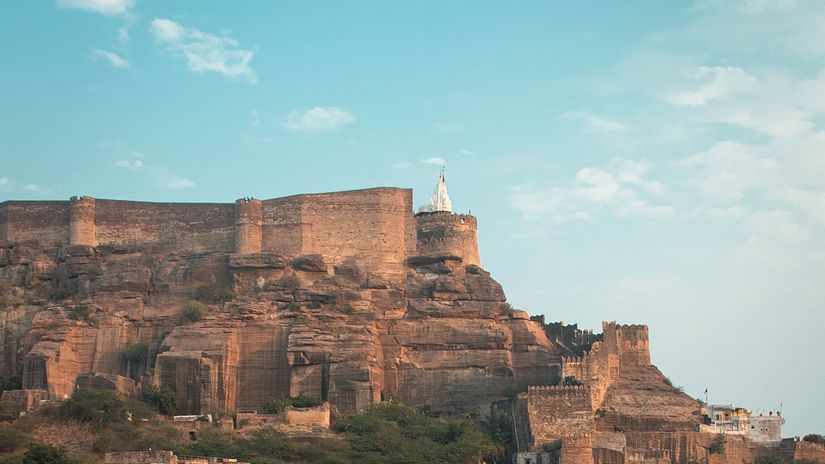- Ranthambore Trip
- Ranthambore Itinerary
- Ranthambore Sightseeing
- Jaipur to Ranthambore
- A Ranthambore Safari Guide
- Best Time to Visit Ranthambore National Park
- Experience The Royal Culture of Rajasthan
- A Summer Vacation in Rajasthan
- Exploring the Eden that is Ranthambore
- A Dive Into the History of Ranthambore Fort
Nestled deep inside Ranthambore National Park, Ranthambore Fort is a UNESCO World Heritage Site under “Hill Forts of Rajasthan”. This majestic fort stands atop a hill of 700 ft. and has played a vital role in the history of Rajasthan.
Rajput King Sapaldaksha of the Chauhan Dynasty laid the foundation of Ranthambore Fort during the mid-10th century. The kings who succeeded him contributed to the construction of the fort. Back in the day, Ranthambore Fort was considered impregnable owing to its strategic development and design. It became one of the many reasons why several rulers wanted to capture the fort!
Rajput King Sapaldaksha of the Chauhan Dynasty laid the foundation of Ranthambore Fort during the mid-10th century. The kings who succeeded him contributed to the construction of the fort. Back in the day, Ranthambore Fort was considered impregnable owing to its strategic development and design. It became one of the many reasons why several rulers wanted to capture the fort!


Ranthambore Fort History
During the Second Battle of Tarain in 1192 CE, Prithviraj Chauhan was defeated by the Ghurids and the fort was captured by Muhammad Ghori. In 1226, the fort was captured by the Sultan of Delhi - Iltutmish. After his death in 1236, Ranthambore Fort was recaptured by the Chauhans. And in 1301, the Sultan of Delhi - Alauddin Khilji, captured the fort and ended the reign of the Chauhan Dynasty.
Later, the fort was captured by the Mewar rulers, and then the Hada rulers. In 1568, it was captured by the Mughal Emperor - Akbar. It stayed under the control of the Mughal rulers till the end of the 18th century. After that, it was returned to the King of Jaipur till India gained independence in 1947.
Later, the fort was captured by the Mewar rulers, and then the Hada rulers. In 1568, it was captured by the Mughal Emperor - Akbar. It stayed under the control of the Mughal rulers till the end of the 18th century. After that, it was returned to the King of Jaipur till India gained independence in 1947.
Ranthambore Fort Architecture
Ranthambore Fort is prominent for its magnificent architecture. The craftsmanship is unmatched with other forts and monuments of that time. The fort is surrounded by numerous stone pathways, thick walls, water tanks, palaces and temples. Built with the stone that was shovelled from the inner region of the fort, the walls represent the power of its architecture.
The fort also houses several historical and architectural sites such as Bada Mahal, Hammir Court, Phansi Ghar and Dhula Mahal.
There are seven elegantly-designed gates, also known as ‘pols’, namely - Navlakha Pol, Hathi Pol, Ganesh Pol, Andheri Pol, Delhi Pol, Sat Pol and Suraj Pol.
The fort also houses several historical and architectural sites such as Bada Mahal, Hammir Court, Phansi Ghar and Dhula Mahal.
There are seven elegantly-designed gates, also known as ‘pols’, namely - Navlakha Pol, Hathi Pol, Ganesh Pol, Andheri Pol, Delhi Pol, Sat Pol and Suraj Pol.

Trinetra Ganesh Temple

Built with red Karauli stone, Trinetra Ganesh Temple is among the oldest temples in India. The temple possesses a magnificent statue of Lord Ganesha, along with his family members. Since Lord Ganesha is considered a powerful God of wealth, wisdom and education, the temple draws devotees in large numbers every year.
At Trinetra Ganesha Temple, the Ganesha is worshipped five times a day, in the form of ‘aartis’.
At Trinetra Ganesha Temple, the Ganesha is worshipped five times a day, in the form of ‘aartis’.
The first worshipping ceremony, known as ‘Prabhat Aarti’ starts in the morning. The second ceremony, known as ‘Shringar Aarti’ is performed at 9:00 a.m. The priests of the temple perform the ‘Bhog’ ceremony at 12:00 p.m. The evening ceremony, called ‘Sandhya’ is performed at 6:00 p.m. And lastly, ‘Shayan Aarti’ is performed at 8:00 p.m., followed by prayers held by the priests and main devotees!


The panoramic views of the Ranthambore National Park from the fort are mesmerizing. The fort’s extraordinary architecture, remarkable fortifications and fascinating history make it a must-visit tourist place in Ranthambore!
On your trip to Ranthambore, make sure to stay at our luxury resort - Baagh Ananta Elite. We are situated on the periphery of Ranthambore National Park. Our lavish rooms and cottages adorned with luxe amenities and services, resplendent dining outlets, a massive swimming pool, and a rejuvenating spa, among others, offer a comfortable stay in Ranthambore.
On your trip to Ranthambore, make sure to stay at our luxury resort - Baagh Ananta Elite. We are situated on the periphery of Ranthambore National Park. Our lavish rooms and cottages adorned with luxe amenities and services, resplendent dining outlets, a massive swimming pool, and a rejuvenating spa, among others, offer a comfortable stay in Ranthambore.